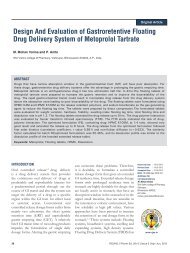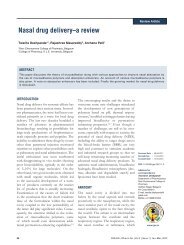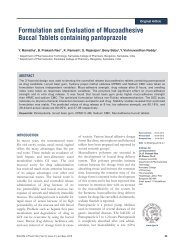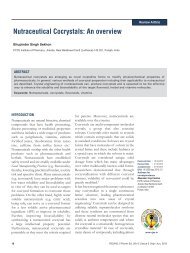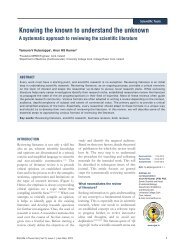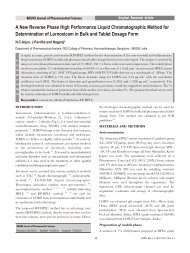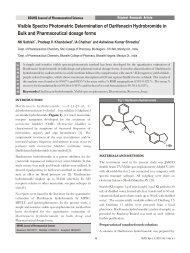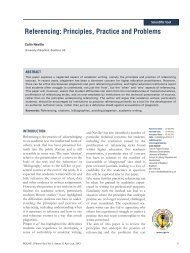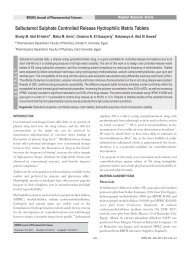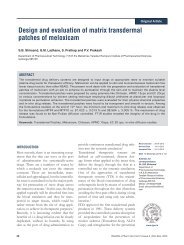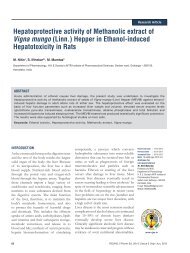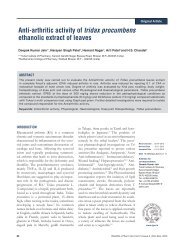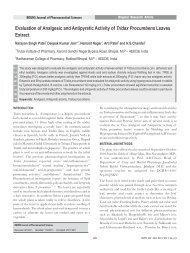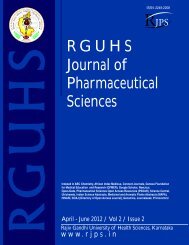Chitosan Loaded Mucoadhesive Microspheres of Gliclazide - Journal
Chitosan Loaded Mucoadhesive Microspheres of Gliclazide - Journal
Chitosan Loaded Mucoadhesive Microspheres of Gliclazide - Journal
Create successful ePaper yourself
Turn your PDF publications into a flip-book with our unique Google optimized e-Paper software.
for seven days in conical flask with occasional shaking and<br />
stirring. The extract was filtered and concentrated to dryness<br />
at room temperature to avoid the decomposition <strong>of</strong> the<br />
9<br />
natural metabolites . Extract was preserved in a refrigerator<br />
till further use. Preliminary phytochemical analysis was<br />
carried out by different methods <strong>of</strong> phytochemical<br />
10<br />
analysis .A known volume <strong>of</strong> extract was suspended in<br />
distilled water and was orally administered to the animals by<br />
gastric intubation using a force feeding needle during the<br />
experimental period.<br />
Preparation <strong>of</strong> dose for dried extract and standard<br />
drugs<br />
Ethanolic extract (500 mg/kg b.w) <strong>of</strong> the selected plant were<br />
formulated as suspension in distilled water using Tween-80 as<br />
suspending agent. The strength <strong>of</strong> the suspension was<br />
according to the dose administered and was expressed as<br />
11<br />
weight <strong>of</strong> dried extract .<br />
Simvastatin 10 mg/kg was used as the reference standard<br />
drug for evaluating the antihyperlipidemic activity which was<br />
made into suspension in distilled water using Tween-80 as a<br />
suspending agent.<br />
Acute oral toxicity studies<br />
Sikarwar Mukesh S et al./ Antihyperlipidemic Effect <strong>of</strong> Ethanolic Extract <strong>of</strong> Hibiscus rosa sinensis Flowers in Hyperlipidemic Rats<br />
The acute oral toxicity studies <strong>of</strong> extract were carried out as<br />
per the OECD guidelines from CPCSEA. Administration <strong>of</strong><br />
the stepwise doses <strong>of</strong> ethanolic extract <strong>of</strong> Hibiscus rosa sinensis<br />
from 50 mg/kg b.w. up to the dose 5000 mg/kg b.w. caused no<br />
considerable signs <strong>of</strong> toxicity in the tested animals. One tenth<br />
<strong>of</strong> upper limit dose were selected as the levels for examination<br />
12<br />
<strong>of</strong> antihyperlipidemic activity .<br />
Diet-induced hyperlipidemic model:<br />
The animals were selected, weighed then marked for<br />
individual identification. Rats were made hyperlipidemic by<br />
the oral administration <strong>of</strong> atherogenic diet for 20 days. The<br />
rats were then given plant extract suspended in 0.2% tween 80<br />
at the dose <strong>of</strong> 500 mg/kg b.w. once daily in the morning<br />
through gastric intubation for 14 consecutive days. During<br />
these days, all the groups also received atherogenic diet in the<br />
same dose as given earlier. The control animals received the<br />
hyperlipidemic diet and the vehicle. At the end <strong>of</strong> treatment<br />
period, the animals were used for various biochemical<br />
13<br />
parameters .<br />
Triton-induced hyperlipidemic model<br />
Animals kept for fasting for 24 h, were injected a saline<br />
solution <strong>of</strong> Triton at the dose <strong>of</strong> 400 mg/kg b.w. intraperitoneally.<br />
The plant extract, at the dose <strong>of</strong> 500 mg/kg b.w.,<br />
were administered orally through gastric intubation. The first<br />
119<br />
dose being given immediately after triton injection and second<br />
dose 20 h later. After 4 h <strong>of</strong> second dose the animals were used<br />
13<br />
for various biochemical parameters .<br />
Experimental design<br />
Animals were divided into four different groups with six<br />
animals in each group. Group I served as normal control,<br />
Group II was positive control which was given standard<br />
antihyperlipidemic drug simvastatin (10 mg/kg/day p.o.).<br />
Group III was hyperlipidemic control and this group did not<br />
receive any treatment except standard pellet diet. Group IV<br />
received ethanolic extract <strong>of</strong> Hibiscus rosa sinensis flowers (500<br />
mg/kg/day, p.o.). Treatment periods for all these groups were<br />
14 days in atherogenic diet-induced hyperlipidemia and 48<br />
hours in case <strong>of</strong> triton-induced hyperlipidemia.<br />
Collection <strong>of</strong> blood<br />
Blood was collected by retro-orbital sinus puncture, under<br />
mild ether anesthesia. The collected samples were centrifuged<br />
at 4000 rpm for 10 minutes.<br />
Biochemical and HPTLC analysis<br />
The serum was assayed for total cholesterol, triglycerides,<br />
phospholipids and high-density lipoprotein (HDL) using<br />
standard protocol method. By using Friedwald formula the<br />
concentration <strong>of</strong> very low density lipoprotein (VLDL) and low<br />
density lipoprotein (LDL) in serum were calculated.<br />
An HPTLC chromatogram <strong>of</strong> active extract was also done by<br />
using CAMAG TLC SCANNER IV, densitometric<br />
evaluation system with CAT s<strong>of</strong>tware instrument was used for<br />
scanning <strong>of</strong> thin layer chromatogram objects in reflectance or<br />
transmission mode by absorbance or by fluorescence at 254 or<br />
366 nm respectively.<br />
Statistical Analysis<br />
The results <strong>of</strong> the study were expressed as mean± S.E.M.<br />
Data was analyzed by using one way analysis <strong>of</strong> variance test<br />
(ANOVA) followed by Dunnett's t-test for multiple<br />
comparisons. Values with (P



